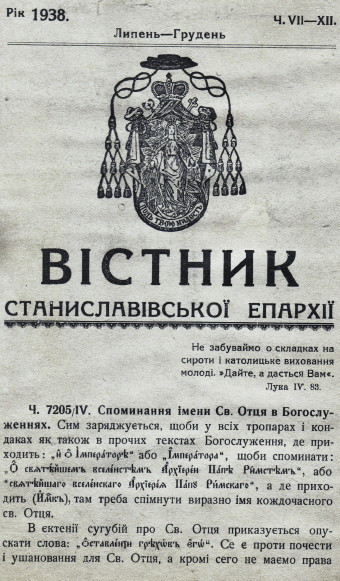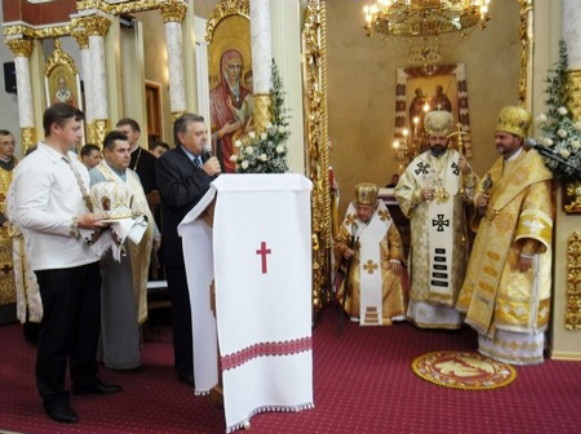Eparchy
Eparchy [епархія; eparkhiia]. An administrative district of the Eastern Christian church headed usually by a bishop (called a diocese in the Roman Catholic church). In the Eastern church a group of eparchies constitutes a metropolitanate (metropoly). Eparchies are divided into deaneries and further into parishes.
In Ukraine eparchies were established under the rule of Prince Volodymyr the Great and were part of Kyiv metropoly. There were 6, perhaps 9 eparchies, of which 4, or perhaps 6, were on Ukrainian ethnic territory. By the time of the Mongol invasion the number of eparchies had increased to 16, of which 10 were on Ukrainian territory: Kyiv eparchy, Chernihiv eparchy, Bilhorod eparchy, Volodymyr-Volynskyi eparchy, Turiv eparchy, Pereiaslav eparchy, Yuriiv eparchy, Peremyshl eparchy, Halych eparchy, and Uhriv eparchy (near Kholm). The boundaries of the eparchies coincided with the boundaries of the principalities, and the cathedrals of the bishops were located in the princes' capitals. Hence, the eparchies covered large areas. Political and administrative changes led to changes in the number and boundaries of the eparchies. Some eparchies declined and disappeared as new ones were formed. Thus, by the end of the 15th century, after the separation from it of Moscow metropoly in 1458, Kyiv metropoly consisted of eight Ukrainian eparchies, of which Kyiv eparchy, Chernihiv eparchy, Turiv–Pynsk eparchy, Lutsk eparchy, and Volodymyr-Volynskyi eparchy were part of the Grand Duchy of Lithuania, and Kholm eparchy, Peremyshl eparchy, Halych eparchy, and two Belarusian eparchies were part of Poland.
After the Church Union of Berestia in 1596 there were two parallel systems of Ukrainian eparchies—one Orthodox and the other Uniate—consisting of the metropolitan eparchy of Kyiv (Kyiv eparchy) and Chernihiv eparchy (Orthodox only), Volodymyr-Berestia eparchy (see Volodymyr-Volynskyi eparchy), Lutsk-Ostrih eparchy, Turiv-Pynsk eparchy, Kholm eparchy, Peremyshl eparchy, and Lviv eparchy. With the decline of the Ukrainian church in the Polish-Lithuanian state the eparchies became impoverished. There were frequent disputes over their land holdings. In the 15th century some of the lands belonging to the Lviv–Halych eparchy (see Lviv eparchy) were taken over by the Roman Catholic archbishop of Lviv.
After the partition of Ukraine between Russia and Austria there were 11 Orthodox eparchies on Ukrainian territory. The following were within the Russian Empire: Kyiv eparchy, Chernihiv eparchy, Poltava eparchy, Kharkiv eparchy, Katerynoslav eparchy, Tavriia eparchy (with its see in Simferopol), Kherson eparchy (see in Odesa), Podilia eparchy (see in Kamianets-Podilskyi), Volhynia eparchy (see in Zhytomyr), and Kholm eparchy (from 1907). In Austria–Hungary there was one Ukrainian-Romanian Orthodox eparchy, with its seat in Chernivtsi (in Rădăuţi until 1783). In 1873 this eparchy was elevated to the metropoly of Bukovyna and Dalmatia. Ukrainian Catholic eparchies existed only within the Austro-Hungarian Empire, because the Uniate church was persecuted and eventually abolished in the Russian Empire. The Ukrainian Catholic eparchies in Galicia were the metropolitan archeparchy of Lviv (see Lviv eparchy), Peremyshl eparchy and Stanyslaviv eparchy (from 1885); in Transcarpathia they were Mukachevo eparchy (see in Uzhhorod), Prešov eparchy (from 1818), and Hajdúdorog eparchy (from 1912, see in Nyíregyháza). Until 1875 the only Ukrainian Catholic eparchy within the Russian Empire was Kholm eparchy.
In the 1920s the old system of eparchies was retained in Soviet Ukraine, but religious persecution resulted in the destruction of the church administrative structure in the 1930s. In the 1920s besides the traditional eparchies there were also eparchies of the Ukrainian Autocephalous Orthodox church, which were called ‘regional [okruha] churches’ in Soviet Ukraine. Their numbers varied, and their boundaries did not coincide with the government-administrative boundaries. Before the Autocephalous church was completely destroyed, it included the following ‘regional churches’: Balta, Berdychiv, Bila Tserkva, Cherkasy, Chernihiv, Hlukhiv, Kamianets-Podilskyi, Katerynoslav (Dnipropetrovsk), Kharkiv, Kyiv, Konotop, Korosten, Lubny, Nizhyn, Poltava, Proskuriv, Pryluky, Romny, Shepetivka, Uman, Vinnytsia, and Volhynia.
When the ‘loyal’ churches in the USSR were granted some freedom after the Second World War, the patriarchal exarchate of Ukraine within the Russian Orthodox church was divided into 18 eparchies, which for the most part coincide with the oblast boundaries; they include Kyiv with two vicariates (Uman and Pereiaslav-Khmelnytskyi), Vinnytsia–Bratslav, Volhynia–Rivne, Zhytomyr–Ovruch, Lviv–Ternopil, Mukachevo–Uzhhorod, Odesa–Kherson, Poltava–Kremenchuk, Simferopol–Crimea, Ivano-Frankivsk–Kolomyia, Kharkiv–Bohodukhiv, Chernihiv–Nizhyn, Chernivtsi–Bukovyna, Kirovohrad–Mykolaiv, and four vacant eparchies—Dnipropetrovsk–Zaporizhia, Voroshylovhrad–Donetsk, Sumy–Okhtyrka, Khmelnytskyi–Kamianets-Podilskyi.
In the 1920s and 1930s the Polish Autocephalous Orthodox church had the following eparchies that covered Ukrainian territory: Volhynia, Warsaw–Kholm, and, in part, Polisia. In 1940–4 the Ukrainians in the German Generalgouvernement belonged to three eparchies: Kholm–Podlachia, Warsaw, and Lemko region–Cracow. After the First World War the Ukrainian Catholic eparchies in Western Ukraine did not change, but a separate Lemko Apostolic Administration was carved out of the Peremyshl eparchy. All these eparchies were abolished by the Soviet authorities after the Second World War.
Outside Ukraine Križevci eparchy was established in 1777 for Ukrainian Catholic settlers in Croatia. In Canada today there are five Ukrainian Catholic eparchies: the metropolitan archeparchy of Winnipeg, and eparchies in Edmonton, Toronto, Saskatoon, and New Westminster. In the United States there are four eparchies: the metropolitan archeparchy of Philadelphia, and eparchies in Stamford, Parma, and Chicago. In addition, there are four Byzantine-rite eparchies for Carpatho-Ruthenians: the archeparchy in Pittsburgh and eparchies in Passaic, Parma, and Van Nuys. There are also Ukrainian Catholic eparchies in Brazil (Curitiba), Argentina (Buenos Aires), Australia (Melbourne), and Poland (Peremyshl-Warsaw and Wrocław-Gdańsk); and exarchates in Great Britain, France, and West Germany. The Prešov eparchy in Slovakia is presently under the direct jurisdiction of the Holy See and functions largely as a Slovak body.
Outside of Ukraine the Ukrainian Orthodox church consists of metropolies without further division into eparchies. In Western Europe there is the Ukrainian Autocephalous Orthodox church (with two bishops). The Ukrainian Orthodox Church in the USA is governed by one metropolitan and two archbishops, with sees in Washington, DC, Chicago, and South Bound Brook, New Jersey. In Canada, the Ukrainian Orthodox Church of Canada (until 1980 officially known as the Ukrainian Greek Orthodox Church of Canada) has been divided since 1951 into three eparchies: central (headed by a metropolitan in Winnipeg), western (see in Edmonton), and eastern (see in Toronto). In 1963 a bishopric was set up in Saskatoon as a vicariate of the central eparchy. Ukrainian Orthodox parishes exist in Argentina, Brazil, Venezuela, Paraguay, and Australia; most of them governed by the metropolitanate in the United States.
After the establishment of Ukraine’s independence the Ukrainian Orthodox Church-Moscow Patriarchate began to expand its eparchial structure beyond its Russian Orthodox base while the new or revived Ukrainian Orthodox jurisdictions—of the Ukrainian Orthodox Church-Kyiv Patriarchate and the revived Ukrainian Autocephalous Orthodox church—started building entirely new ones. The re-established Ukrainian Catholic church in Ukraine set up the eparchies of Lviv, Buchach, Ivano-Frankivsk, Kolomyia-Chernivtsi, Mukachevo, Sambir-Drohobych, Sokal, Stryi, and Ternopil as well as the exarchates of Donetsk-Kharkiv and Kyiv-Vyshhorod.
(For the administration of eparchies, see Bishop.)
[This article was updated in 2013.]

